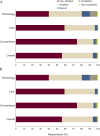Virtual visits for Parkinson disease: A multicenter noncontrolled cohort
- PMID: 28840919
- PMCID: PMC5566796
- DOI: 10.1212/CPJ.0000000000000371
Virtual visits for Parkinson disease: A multicenter noncontrolled cohort
Abstract
Background: Previous small-scale studies have demonstrated the feasibility of providing remote specialty care via virtual visits. We assessed the feasibility and benefits of a one-time consultation between a remote Parkinson Disease (PD) specialist and an individual with PD at home on a larger scale.
Methods: We conducted a multicenter noncontrolled cohort of virtual visits administered over videoconferencing between remote PD specialists and individuals with PD in their home. Specialists performed a patient history and a PD-specific physical examination and provided recommendations to patients and their local physicians. The primary outcome measures were feasibility, as measured by the proportion of visits completed as scheduled, and the 6-month change in quality of life, as measured by the Parkinson's Disease Questionnaire 39. Additional outcomes included satisfaction with visits and interest in future virtual visits.
Results: A total of 277 participants from 5 states enrolled, 258 participants completed virtual visits with 14 different physicians, and 91% of visits were completed as scheduled. No improvement in quality of life was observed at 6 months (0.4-point improvement; 95% confidence interval -1.5 to 0.6; p = 0.39). Overall satisfaction with virtual visits was high among physicians (94% satisfied or very satisfied) and patients (94% satisfied or very satisfied), and 74% of participants were interested in receiving future care via virtual visits.
Conclusions: Providing specialty care remotely into the homes of individuals with PD is feasible, but a one-time visit did not improve quality of life. Satisfaction with the visits was high among physicians and patients, who were interested in receiving such care in the future.
Classification of evidence: This study provides Class IV evidence that for patients with PD, remote specialty care is feasible but does not improve quality of life.
Clinicaltrialsgov identifier: NCT02144220.
Figures




References
-
- Dorsey ER, Topol EJ. State of telehealth. N Engl J Med 2016;375:154–161. - PubMed
-
- Levine SR, Gorman M. “Telestroke”: the application of telemedicine for stroke. Stroke 1999;30:464–469. - PubMed
-
- Silva GS, Farrell S, Shandra E, Viswanathan A, Schwamm LH. The status of telestroke in the United States: a survey of currently active stroke telemedicine programs. Stroke 2012;43:2078–2085. - PubMed
-
- Kepplinger J, Barlinn K, Deckert S, Scheibe M, Bodechtel U, Schmitt J. Safety and efficacy of thrombolysis in telestroke: a systematic review and meta-analysis. Neurology 2016;87:1344–1351. - PubMed
-
- Hess DC, Audebert HJ. The history and future of telestroke. Nat Rev Neurol 2013;9:340–350. - PubMed
Associated data
LinkOut - more resources
Full Text Sources
Other Literature Sources
Medical
Research Materials
